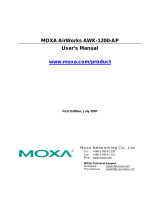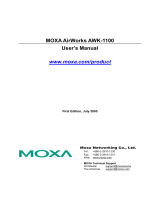
- 13 -
5.18 to 5.24 GHz (4 channels for W52)
Security: • SSID broadcast enable/disable
• Firewall for MAC/IP/Protocol/Port-based filtering
• 64-bit and 128-bit WEP encryption,
WPA/WPA2-Personal and Enterprise (IEEE
802.1X/RADIUS, TKIP and AES)
Transmission Rates: 802.11b: 1, 2, 5.5, 11 Mbps
802.11a/g: 6, 9, 12, 18, 24, 36, 48, 54 Mbps
802.11n: 6 to 300 Mbps (multiple rates supported)
TX Transmit Power:
802.11b:
1 to 11 Mbps: Typ. 18 dBm (± 1.5 dBm)
802.11g:
6 to 24 Mbps: Typ. 18 dBm (± 1.5 dBm)
36 to 48 Mbps: Typ. 17 dBm (± 1.5 dBm)
54 Mbps: Typ. 15 dBm (± 1.5 dBm)
802.11a:
6 to 24 Mbps: Typ. 17 dBm (± 1.5 dBm)
36 to 48 Mbps: Typ. 16 dBm (± 1.5 dBm)
54 Mbps: Typ. 14 dBm (± 1.5 dBm)
TX Transmit Power
MIMO:
802.11a/n (20/40 MHz):
MCS15 20 MHz: Typ. 13 dBm (± 1.5 dBm)
MCS15 40 MHz: Typ. 12 dBm (± 1.5 dBm)
802.11g/n (20/40 MHz):
MCS15 20 MHz: Typ. 14 dBm (± 1.5 dBm)
MCS15 40 MHz: Typ. 13 dBm (± -1.5 dBm)
RX Sensitivity:
802.11b:
-92 dBm @ 1 Mbps, -90 dBm @ 2 Mbps, -
@ 5.5 Mbps, -84 dBm @ 11 Mbps
802.11g:
-87 dBm @ 6 Mbps, -86 dBm @ 9 Mbps, -
@ 12 Mbps, -82 dBm @ 18 Mbps, -80 dBm @ 24
Mbps, -76 dBm @ 36 Mbps, -72 dBm @ 48 Mbps,
-70 dBm @ 54 Mbps
802.11a:
-87 dBm @ 6 Mbps, -86 dBm @ 9 Mbps, -
@ 12 Mbps, -82 dBm @ 18 Mbps,
-80 dBm @ 24 Mbps, -76 dBm @ 36 Mbps, -72
dBm @ 48 Mbps, -70 dBm @ 54 Mbps
802.11a/n:
-68 dBm @ MCS15 40 MHz, -70 dBm @ MCS7 40
MHz, -69 dBm @ MCS15 20 MHz, -71 dBm @
MCS7 20 MHz
802.11g/n:
-68 dBm @ MCS15 40 MHz, -70 dBm @ MCS7 40
MHz, -69 dBm @ MCS15 20 MHz,
-71 dBm @ MCS7 20 MHz
General Protocols: Proxy ARP, DNS, HTTP, HTTPS, IP, ICMP, SNTP,
TCP, UDP, RADIUS, SNMP, PPPoE, DHCP
AP-only Protocols: ARP, BOOTP, DHCP, dynamic VLAN-Tags for
802.1X-Clients, STP/RSTP (IEEE 802.1D/w)
Default Antennas: 2 dual-band omni-directional antennas, 5 dBi at
2.4 GHz, 2 dBi at 5 GHz, N-type (male)
Connector for External Antennas: N-type (female)





















